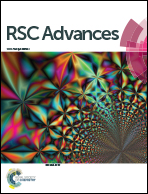Ultrasonic-template technology inducing and regulating cationic microblocks in CPAM: characterization, mechanism and sludge flocculation performance†
Abstract
In this study, the ultrasonic-template polymerization technique (UTPT) was used to generate and regulate the distribution of cationic microblocks in a polymer. The ultrasonic-template copolymer (TPAD-U) of acrylamide (AM) and methacryloxyethyl trimethyl ammonium chloride (DMC) with a novel cationic microblock structure was successfully synthesized through UTPT using sodium polymethacrylate (PMAA) as the template. Fourier transform infrared spectroscopy (FT-IR), 1H (13C) nuclear magnetic resonance spectroscopy (1H (13C) NMR), scanning electron microscopy (SEM) and thermogravimetric analysis (TGA) were employed to characterize the properties of the polymers. The results showed that evident cationic microblocks formed in TPAD-U. Moreover, the template polymerization mechanism and reaction kinetics were analyzed, and the results showed that the I (ZIP) mechanism and free radical termination were assigned to template copolymerization. The I (ZIP) template mechanism convincingly indicated the formation of the cationic microblocks. The sludge dewatering results demonstrated that TPAD-U showed a better sludge flocculation performance than flocculants prepared by the non-template polymerization technique. During the sludge flocculation process, the cationic microblocks in TPAD-U greatly enhanced the effects of charge neutralization and bridging, which contributed much to a prominent flocculation performance.



 Please wait while we load your content...
Please wait while we load your content...